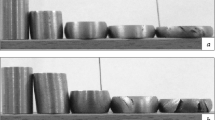Conclusions
-
1.
Anomalous changes in plastic properties according to deformation temperature occur with changes in percentage elongation. reduction of area, and impact strength, i.e., in deformation with various stressstate patterns. The temperatures at which plastic properties begin to grow and reach their maxima fall as stability of austenite increases.
-
2.
The anomalous growth in plasticity at various deformation temperatures may be utilized in the manufacture of formed products, particularly tubes, in stainless steels.
-
3.
The data obtained can be used as a basis for calculating optimum temperature conditions for rolling steels ÉI711, 000Kh18N12, and ÉI847 with various degrees of deformation.
Similar content being viewed by others
Literature Cited
M. G. Gaidukov and V. D. Sadovskii, Metal. i Term. Obrabotka Metallov, No. 5, 4 (1958).
Yu. G. Virakhovskii, I. Ya. Georgieva, et al., Fiz. Met. i Metal., No. 32 (1971).
D. A. Bolstad and E. C. Roberts, Trans. ASM,56 (1963).
G. Friedel, Dislocations [Russian translation], Mir, Moscow (1967).
Additional information
All-Union Tube Scientific-Research Institute, Dnepropetrovsk. Translated from Problemy Prochnosti, No. 12, pp. 105–107, December, 1974.
Rights and permissions
About this article
Cite this article
Voitselenok, S.L., Lysyak, A.V. & Burnos, V.A. Anomalous growth in plasticity in stable and metastable austenitic steels. Strength Mater 6, 1529–1531 (1974). https://doi.org/10.1007/BF01529839
Received:
Issue Date:
DOI: https://doi.org/10.1007/BF01529839



